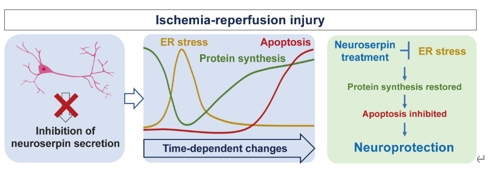中国神经再生研究(英文版) ›› 2026, Vol. 21 ›› Issue (1): 333-345.doi: 10.4103/NRR.NRR-D-24-00044
Neuroserpin可通过抑制内质网应激减轻缺血性脑卒中损伤
Neuroserpin alleviates cerebral ischemia-reperfusion injury by suppressing ischemia-induced endoplasmic reticulum stress
Yumei Liao1, 2, 3, #, Qinghua Zhang3, #, Qiaoyun Shi3, #, Peng Liu2, 3, Peiyun Zhong3 , Lingling Guo2, 3, Zijian Huang2, 3, Yinghui Peng2, 3, Wei Liu4 , Shiqing Zhang2, 3, István Adorján5 , Yumi Fukuzaki6 , Eri Kawashita7 , Xiao-Qi Zhang2, 3, Nan Ma2, *, Xiaoshen Zhang1, 8, *, Zoltán Molnár9, *, Lei Shi1, 2, 3, *
- 1 Department of Cardiovascular Surgery, The First Affiliated Hospital, Jinan University, Guangzhou, Guangdong Province, China; 2 State Key Laboratory of Bioactive Molecules and Druggability Assessment, Jinan University, Guangzhou, Guangdong Province, China; 3 JNU-HKUST Joint Laboratory for Neuroscience and Innovative Drug Research; Guangdong Province Key Laboratory of Pharmacodynamic Constituents of TCM and New Drugs Research, College of Pharmacy, Jinan University, Guangzhou, Guangdong Province, China; 4 Shenzhen Key Laboratory for Neuronal Structural Biology, Biomedical Research Institute; Institute of Geriatric Medicine, Peking University Shenzhen Hospital, Shenzhen Peking University-The Hong Kong University of Science and Technology Medical Center, Shenzhen, Guangdong Province, China; 5 Department of Anatomy, Histology and Embryology, Semmelweis University, Budapest, Hungary; 6 Department of Neurology, University of California, San Francisco, San Francisco, CA, USA; 7 Department of Pathological Biochemistry, Kyoto Pharmaceutical University, Yamashina-ku, Kyoto, Japan; 8 School of Nursing, Jinan University, Guangzhou, Guangdong Province, China; 9 Department of Physiology, Anatomy and Genetics, University of Oxford, Oxford, UK
摘要:
神经丝氨酸蛋白酶抑制剂Neuroserpin是一种分泌蛋白,可在中枢神经系统中高表达,对大脑发育和病理损伤有着重要的作用;其也是一种组织型纤溶酶原激活剂的天然抑制剂,可抑制缺血条件下组织型纤溶酶原激活剂活性的增加,并可延长组织型纤溶酶原激活剂的治疗时间窗。然而,Neuroserpin对缺血性脑卒中的神经保护机制尚不完全清楚。实验基于大脑中动脉阻塞小鼠模型和氧糖剥夺再灌注皮质神经元模型模拟缺血性脑卒中损伤,并以Neuroserpin进行干预。结果显示,缺血再灌注损伤早期会出现内质网应激,其特征是神经元内质网应激蛋白传感器快速且短暂地激活,随后诱发细胞凋亡反应。缺血性脑卒中会显著抑制皮质神经元中Neuroserpin的表达。而外源性Neuroserpin可逆转多种内质网应激信号分子激活、蛋白质合成降低及凋亡转录因子表达,进而减少氧糖剥夺再灌注诱导的神经元死亡和大脑中动脉阻塞小鼠的脑梗死和神经功能障碍。同时,内质网应激诱导剂毒胡萝卜素(Thapsigargin)和衣霉素(Tunicamycin)可显著抑制Neuroserpin的神经保护作用。综上表明,Neuroserpin通过抑制内质网应激而发挥对缺血性脑卒中的神经保护作用。
https://orcid.org/0000-0002-8518-5627 (Nan Ma); https://orcid.org/0009-0005-5473-2631 (Xiaoshen Zhang);
https://orcid.org/0000-0002-6852-6004 (Zoltán Molnár); https://orcid.org/0000-0001-8695-3432 (Lei Shi)
